Did you know that Robert Frost studied historical geology with
Nathaniel Southgate Shaler (something of the Stephen Jay Gould of his time) when
he entered Harvard College in 1898?
Chapter 5: Minerals, Rocks & Rock Forming Processes
When we discussed the beginnings of the universe, we noted the dropping temperatures
were essential for the organization of matter as we know it. First the subatomic
particles (quarks, electrons, etc.) were able to form, when temperature dropped further
quarks were able to organize into protons and neutrons, then these were able to form
simple atomic nuclei, and finally neutral atoms of hydrogen and helium could form when
temperatures had dropped even lower. The remaining elements of the periodic table were
produced via successive nuclear fusion in stars (up to iron), and under the intense
pressures and temperatures of supernova explosions (up to uranium).
When the Earth and other planets accreted around 4.5-4.6 billion years ago, they
contained a mixture of all the elements, and the relative abundances probably reflected
the cosmic abundances
indicated by spectroscopic studies. What happened to that mixture once the Earth
started to heat up and differentiate? Basically,
whenever
chemical elements (atoms) are brought together
there is a tendency for them to react with each other and to form compounds. How
this works exactly is the subject of thermodynamics or physical chemistry, a subdiscipline
of chemistry. Thermodynamics
allows us to calculate the outcome of chemical reactions when we bring certain substances
together.
What kind of compounds form in a given mixture of elements depends in part on their
relative abundance, and in part on whether a given combination produces an
energy-releasing reaction (exothermic, for example when gasoline combines with oxygen and
explodes), or whether it requires energy input to react (endothermic, for example the
synthesis of ammonia from nitrogen and hydrogen).
The material that was displaced into the mantle during formation of the iron core
contained abundant oxygen, silica, magnesium, iron, aluminum, and calcium (plus smaller
quantities of a range of other elements) and under the pressures and temperatures that
prevail there, chemical reactions (following the laws of thermodynamics) produce compounds
that are known as olivine and pyroxene. During formation of the crust, other
compounds, in particular feldspars and quartz were common reaction products. The
atoms and molecules in these
compounds are present in
compound-specific proportions, and they are not randomly distributed. Instead, they
show very specific geometric arrangements. These compounds that make up the crust and
mantle are commonly known to us as
minerals.
Minerals, the building blocks of rocks, are inorganic solids with a
specific internal structure and a definite chemical composition (varies only within a
narrow range). They can form under a variety of conditions, such as:
- A) during the cooling of molten materials (steel, from lavas, igneous rocks).
- B) during the evaporation of liquids
(salt, sugar, reference to evaporites)
- C) the cooling of liquids (saturated solution)
- D) at high temperatures and pressures new crystals may grow in solid materials (diamonds
from coal, metamorphism)

Mineral precipitation from solution:
Calcite dripstones form from calcite
saturated groundwater in cave |
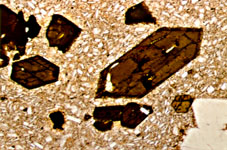
Mineral formation in silicate melt:
Hornblende crystals (brown) in a lava
flow |
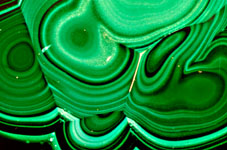
Mineral precipitation from solution:
Malachite (a copper carbonate)
precipitated in open spaces of a
copper deposit. Each band marks a
growth episode. |

A slice of a Tourmaline crystal.
Shows growth zonation. |
Minerals can be classified into several groups according to their chemical
composition.
These groups are:
- 1) Elements
(carbon [diamond],
sulfur, zinc, gold, etc.)
- 2) Halides (element and halogen, such as chlorine, bromine, or iodine;
one example is table salt [sodium chloride])
- 3) Oxides (element and oxygen, e.g. hematite [iron oxide])
- 4) Sulfides (element and sulfur, e.g. pyrite [iron sulfide], galena
[lead sulfide])
- 5) Elements and complex ions (ion not just a single charged atom),
common examples are:
a)
Carbonates (CO32-) (calcite, egg shells)
b) Sulfates (SO42-) (gypsum)
c) Silicates (SiO44-) (feldspar, quartz)
THE RELATIVE ABUNDANCE OF MINERALS in the earth's crust and mantle is governed by the
relative abundance of the elements in these units. If we for example consider the weight
fractions of elements in the crust, it is obvious that
 |
Oxygen is by far the most abundant, followed by Silica and Aluminum.
The
elements from Oxygen to Magnesium make up 98.5% of the crust and are called "major"
elements. The elements that make up the remaining 1.5% are called the minor
elements (abundance some tenth of a percent) and the trace elements (abundance
measured in ppm). |
Minerals in the Earth's Crust
There are more than 3000 known minerals (the number is still growing), but of these
only about 20 are very common, and only 9 of these constitute 95% of the crust.
These 9 minerals are all silicates, and are also called the
rock forming minerals.
They can be subdivided into two groups, the
mafic and
felsic
minerals according to the principal rocks types they mainly occur in.
Mafic Minerals: The term mafic is used for silicate minerals,
magmas, and rocks which are relatively high in the heavier elements (dominated by Fe, Mg,
Ca, Al, SiO2; Ma stands for magnesium and F stands for iron). The minerals are:
Of these minerals, the first four are of
dark (almost black) to
greenish color, and the
last one (Ca-Plagioclase) is light to transparent. Thus,
mafic rocks are overall of
dark color. Mafic magmas are usually produced at
spreading centers, and
represent material which is newly differentiated from the upper mantle.
Common
mafic rocks
include basalt and gabbro.
Felsic Minerals: Felsic is a term used for silicate minerals, magmas,
and rocks which have a lower percentage of the heavier elements, and are correspondingly
enriched in the lighter elements, such as silica and oxygen, aluminum, and potassium. The
term is a combination of FEL (for feldspar; in this case the potassium-rich variety)
and SIC (indicating a higher percentage of silica). The minerals are:
Felsic minerals are light in color and
felsic rocks are therefore typically of light
color. The most common
felsic rocks are granite and
rhyolite, which (as we shall see
later) represent the end product of the Earth's crustal differentiation process. Rocks
that are intermediate in composition between these two groups are also called (surprise!)
the intermediate rocks. All of these minerals form through crystallization from silicate
melts in the crust and mantle.
Silicate Minerals
I f we look at the composition of the 9 rock forming minerals, we see that they all
belong into the silicate group of minerals. The
basic
buildingstone of silicate
minerals is the SiO44- complex ion,
the silica tetrahedron.
Oxygen and Silica are the most abundant elements in the crust and mantle, and they form
the strongly bonded SiO44- complex over a wide range of conditions
(from the P/T conditions of the mantle to the P/T conditions of the Earth surface).
This complex is even stable in silicate melts, and because more than 90% of the Earth's
crust is made of these two elements (more than 70% by weight), it is easy to understand
why practically all the minerals in the crust (and mantle) are composed of silica
tetrahedra with a variety of other elements sprinkled (not at random of course) among
them.
Although we talk of the nine rock forming minerals, they are really families of
minerals with the same structural styles (in fact three of the rock forming minerals,
albite, orthoclase, plagioclase are all from the feldpar family). In each of these
"families" there is a basic framework/geometric arrangement of
silica tetrahedrons, and the difference between "family members" is
primarily in the types and abundances of other chemical elements that participate in the
structure.
Despite the limited number of components, the large number of resulting silicate
minerals have very distinct crystalline structures, and equally distinct physical and
chemical properties. At first glance it may seem surprising that with a comparatively
small number of components, and the silica tetrahedron as the dominant constituent, we can
produce such a vast array of different compounds and structures. But if you were to
play with a box full of tetrahedrons, you would soon realize that tetrahedrons are very
versatile geometrically, and allow the construction of many different shapes and
structures. In that sense the versatile
silicone (and the silica tetrahedron) plays
in the world of inorganic chemistry a similar role as the carbon in the world of organic
chemistry (both have tetrahedral arrangements of their external electrons/charges). And
indeed, the two elements are direct neighbors in the periodic system and thus show many
parallels in their chemical behavior.
ROCKS
The materials that the Earth's crust is made of are called rocks, and all rocks are
made of minerals. Minerals are to rocks what vegetables are to a salad. If you know
what vegetables are in your salad, you can tell what kind of salad you have. Likewise, if
you can identify the minerals in your rock, you can name it. Minerals are the fundamental
unit for understanding rocks. Geologists distinguish three main groups of rocks
(with of course numerous subdivisions):
- IGNEOUS ROCKS
- SEDIMENTARY ROCKS
- METAMORPHIC ROCKS
Igneous Rocks
Igneous Rocks are formed by the cooling and
crystallization of a silicate melt (dominated by oxygen and silicon, with a variety of
other metals). The occurrence and distribution of igneous rocks and igneous rocks
types can be related to the operation of plate tectonics. The molten rock material from
which igneous rocks form is called
magma.
Magma is molten silicate
material and may include already formed crystals and dissolved gases. The name magma
applies to silicate melts within the Earth's crust,
when magmas reach the surface they are
referred to as lava. The principal constituents of a magma are
(remember abundances of elements in the crust) O, Si, Al, Ca, Na, K, Fe, and Mg. The
properties of a magma (viscosity, melting point) are largely controlled by the SiO2
(viscosity) and the H2O content (melting point). SiO2 is the most
abundant component and ranges in abundance from 35% in mafic rocks to 75% in felsic rocks.
Two Dissolved gases, CO2 and H2O, are important even though they are
not the most abundant components.
The Origin of Magmas

The origin of magmas has been a subject for considerable scientific debate in the first
half of this century, but today it is basically agreed that three principal magma families
(see above) can distinguished, basaltic,
andesitic, and
granitic, and that they are all
the
product of partial melting.
Basaltic Magmas have comparatively
low silica contents (about 50%) and
have temperatures between 900 and 1200 degrees Celsius. They are rich in iron and
magnesium and form through partial melting of the upper mantle (from peridotite) in areas
of mantle upwelling and high heatflow (mid-oceanic ridges; continental rifts).
Andesitic Magmas
are intermediate in composition between basalts and
granites. They form trough partial melting of
subducted ocean crust
in areas of crustal convergence (subduction zones). In areas of island arc formation they are the
dominant magma type. In areas of crustal compression and thickening (subduction near
continent) they occur together with granitic magmas that originate in the lower crust.
Granitic magmas have
high silica contents (60-70%) and usually have
temperatures below 800 degrees Celsius. They originate in the lower crust in the deeply
buried "root zones" of mountain belts. In these areas the temperatures of
deeply buried rocks become high enough to allow
partial melting. The melts that form
under these conditions are granitic in composition.
Because of their lower temperature and high silica content
granitic magmas tend to be
highly viscous (linked domains of silica tetrahedra), whereas
basaltic magmas are of low
viscosity (much more fluid), and are able to flow (Hawaii). Andesitic magmas are in
between these extremes.
The various kinds of igneous rocks can be distinguished by
mineral composition,
chemical composition (linked to minerals), and
texture.
Texture
describes the way the minerals in the rock look like and relate to each other (large vs
small; ideal crystal shapes or irregular grains; etc.), and is in large parts influenced
by the cooling history of the magma.
The so called EXTRUSIVE ROCKS are those that make it to the surface of
the Earth in a molten state, tend to cool quickly, and have therefore typically have small
crystals (fast cooling does not allow large crystals to grow). The resulting
textures are called
aphanitic
(fine grained),
glassy
and
porphyritic
(if some crystals formed before extrusion). Thus these
textures are typical for volcanic
rocks. Gas bubbles (pressure drop at eruption) may give rise to
vesicular and
frothy textures.
Pyroclastic
textures are found in volcanic rocks that formed from ashfalls and ashflows.
The so called INTRUSIVE ROCKS are those that do not make it to the
surface and cool down slowly inside the crust. Thus we see mainly
phaneritic textures
with minerals of coarse to intermediate grain size. If these rocks form at very shallow
depths they may be called hypabyssal or subvolcanic rocks, and we may also see porphyritic
textures (e.g. dykes and sills). If they form at considerable depth they are called
plutonic rocks and the respective rock bodies may be called stocks, or batholiths, or
plutons.
Igneous Rocks and Mineral Composition
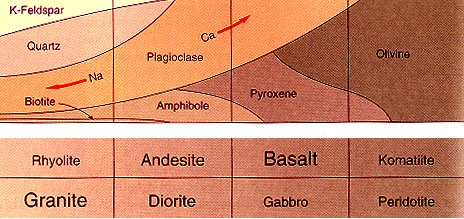 |
Mineral Composition
Name for Extrusive Rock
Name for Intrusive Rock |
This diagram shows the main groups of igneous rocks, their main mineral constituents
and their intrusive (cooling in the crust) and extrusive (cooling as lava flow)
equivalents. For example: granitic magmas solidify to granite if they cool in
the crust (intrusive), but are called
rhyolites if they cool down after they reach the
Earth's surface as lava flows (extrusive). Both, rhyolites and granites, are
composed of K-feldspar, Quartz, Sodium Plagioclase, and Biotite. Peridotite is the
name for rocks of the upper mantle, and Komatiite is the name for extrusive lavas that are
essentially of Peridotite composition. The latter are found primarily in very old
rocks (Archean) that formed soon after the formation of the first crust (crust was thin,
very mobile, and convection was vigorous).
THE MAGMA TEMPERATURE AND THE CHEMICAL COMPOSITION OF THE MAGMA DETERMINE WHAT MINERALS
CRYSTALLIZE AND THUS WHAT KIND OF IGNEOUS ROCK WE GET. Different minerals crystallize at
different temperatures (olivine at high temperatures, quartz at low temperatures), and
therefore the mineral composition of an igneous rock can tell us something about the
cooling history of that rock. The realization that types and modes of occurrences of
igneous rocks can be tied to a common history of cooling, was formulated by the petrologist Bowen, who related laboratory experiments on mineral crystallization with
petrographic observations in a theoretical scheme that is nowadays known as
BOWEN'S REACTION SERIES.
Naming Bodies of Igneous Rocks
Bodies of igneous rocks come in a large variety of shapes and sizes, and geologists
use a variety of terms to describe these. A small sample of these terms is shown in
the figure below.
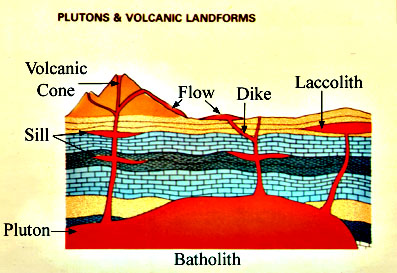 |
Rock bodies that cool beneath the surface are generally described as Plutons.
A batholith
is a large former magma chamber, often many miles across. A sill is a
sheetlike injection of magma between layers of sedimentary rock. A dike is a sheetlike
body that fills a fracture that cuts across other rocks. A laccolith is a small
magma chamber at shallow depth (roughly lens shaped). Volcanic cones
and lava flows are surface expressions (see volcanic landforms for
pictures). All of the subsurface igneous rock bodies will eventually be exhumed by
erosion and can be seen at the surface. Erosion may reveal the solidified magma plug
in the base of volcanoes, a so called volcanic neck. |
Volcanic Processes and Landforms
The processes which lead to the deposition of extrusive igneous rocks can be studied in
action today, and help us to explain the textures of ancient rocks with respect to
depositional processes.
Some of the
major features of volcanic landforms and volcanic processes are summarized in the attached
pages.
Under heaven nothing is more soft and yielding than water.
Yet for attacking the solid and strong, nothing is better;
It has no equal.
Lao Tzu, The Tao Te Ching
Sedimentary Rocks
Sedimentary Rocks
are a product of the surface processes of
the earth (weathering, erosion, rain,
streamflow, wind, wave action, ocean circulation).
The starting material for sedimentary rocks are the rocks outcropping on the continents.
Processes of physical and chemical weathering break down these source materials into the
following components:
- small fragments
of the source rock (gravel, sand, or silt size) that
may be identifiable rock fragments or individual minerals
- new minerals
produced by weathering processes (mainly clays)
- dissolved portions of the source rock ( dissolved salts in river and
ocean water)
From accumulations of these materials ( fragmental material, clays, and dissolved
salts) do all sediments on the earth's surface form.
Sediments may form by:
- mere mechanical accumulation
(wind, water) such as gravel and sand deposits in a
river or sand dunes in a desert
- chemical precipitation, such as salt and calcite precipitation in shallow seas
and lakes
- activity of organisms, such as carbonate accumulation in coral reefs (organic
precipitation), or accumulation of organic matter in swamps (coal precursor)
Sedimentary rocks form when these initial sediments solidify by cementation and
compaction.
The probably most significant feature of sedimentary rocks is the fact that they are
stratified, that means the
sediments of any particular time period form a distinct layer that is underlain and
overlain by equally distinct layers of respectively older and younger times. Therefore
sediments are the preserved record of former climates and landscapes.
The study of
sedimentary rocks allows therefore to look back in time and to decipher the sequence of
events that made today's Earth what it is. In addition, because the
animals that lived
during these time periods are found preserved in their respective sediment units, a record
of the animal and plant life is kept throughout Earth history. This record allows us to
see the changes of plant and animal communities through a time interval of more than 3
billion years (3.2 b.y. the oldest algae) and is therefore a prime piece as well as a
prime source of evidence for the theory of
evolution.
Stratification is also observed in sedimentary rocks from other planets, such as
Mars (sedimentary layers from
Mars orbit, sedimentary layers at
Mars surface).
Because sedimentary processes shape the surface of the earth, the processes that form
sediments are much more accessible to observation, and because about 75% of the earth's
exposed land surface consist of sediments and sedimentary rocks, most people have more
familiarity with sedimentary rocks than with igneous or metamorphic rocks. Because we can
study them in the making, we probably know more details about the origin of sedimentary
rocks, than that of igneous and metamorphic rocks combined.
Types of Sedimentary Rocks
Several different types of sedimentary rocks can be distinguished according to mineral
composition, and origin of the sediment. The main groupings are:
- Clastic Sedimentary Rocks, subdivided into
conglomerates
sandstones
mudstones/shales
- Chemical and Biochemical Sedimentary Rocks, subdivided into
limestone/dolostone
evaporites
carbonaceous rocks
Clastic Sedimentary Rocks
are those that are composed of fragments of
other rocks (igneous, metamorphic, sedimentary). Depending on grain size they are
subdivided into conglomerate (grain size larger than 2 mm), sandstone
(size between 2 mm and 0.0625 mm), and shale (mudstone).
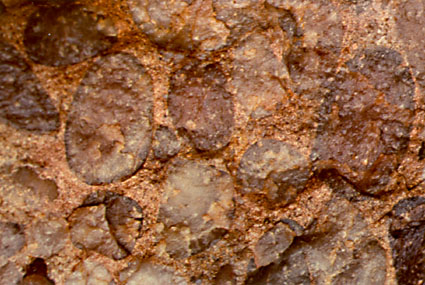 |
CONGLOMERATES
(size of particles above 2 mm) are consolidated gravel
deposits with variable amounts of sand and mud between the pebbles, and are the least
abundant sediment type (a few %). They usually occur as lenticular bodies that are
interbedded with sandstones and sometimes mudstones. Conglomerates accumulate in stream
channels (mountain streams), along the margins of mountain ranges (brought out by
streams), and may also accumulate on beaches. The basic conditions for formation are
either closeness to a source area (usually high relief, fast flowing streams), and/or a
high energy environment of deposition (beach, winnowing is the important ingredient). The
source rock of a conglomerate can easily be determined by examining the
lithology of the
pebbles (granite pebbles, basalt pebbles, etc.). |
SANDSTONES
(particle size between 2 mm and 0.0625 mm) comprise about 30% of all
sedimentary rocks. Because in many igneous and metamorphic source rocks the grain size of
component minerals is larger than or equal to that of sandstones, it is much more
difficult to determine the source rock of a sandstone (as compared to a conglomerate).
The most abundant mineral in a sandstone is usually quartz, because it is the hardest
one of the rock forming minerals and therefore the most resistant to abrasion during
transport. The second most abundant mineral is feldspar (potassium feldspar), followed by
micas. These minerals are also the chemically most stable (under conditions of the Earth's
surface) among the rock forming minerals. The softer and less stable minerals (hornblende,
pyroxene, olivine) are absent or at least fairly rare. Even though the mineral composition
of a sandstone does not give us lots of direct clues as to the source rock composition,
we
can gain some insight into climate and transport history from the mineral composition of a
sandstone.
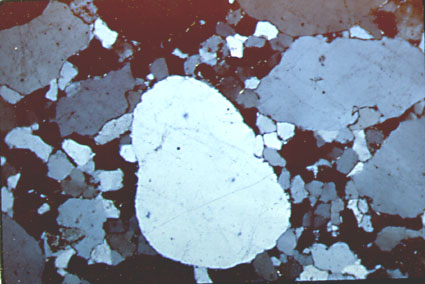 |
E.G. in the case of a quartzite (or quartz arenite), a sandstone that
consists more or less entirely of quartz grains (see picture at left, about 4 mm wide), we
may assume that chemical weathering in the source area was very effective, or, that the
transport path was very long (multicyclicity). In the case of a sandstone that contains
abundant feldspars on the other hand we may assume that the source area was relatively
close, and that chemical weathering was less intense. The degree of rounding of sand
grains may also be an indicator of transport history (rounding of grains also
distinguishing mark when compared to igneous rocks). The sand particles in a sandstone are
usually cemented together by calcite, silica (quartz), iron oxide and clays (either single
or in combination). |
SHALE OR MUDSTONE consists of consolidated mud (clay and other fine particles),
and comprises about 60-70% of the sedimentary rocks on earth.
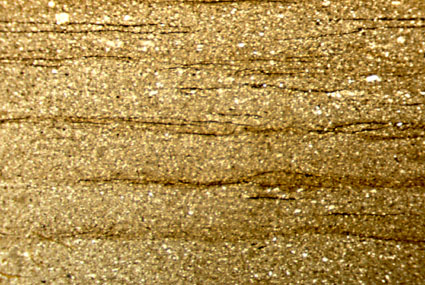 |
Shale is not as conspicuous as sandstone because it is
softer, and therefore tends to
form smooth hills and slopes during weathering. Generally they require a relatively quiet
environment of deposition (deep sea, lagoon, lake, tidal flat) because otherwise the fine
material can not settle out of the water (too much agitation). The color of a shale may
indicate if deposition occurred in stagnant water (black, organic matter), or in an
oxidizing environment (well aerated, usually higher energy level). The image at left
shows a photomicrograph of a shale, taken at the same magnification as the photo of
sandstone above. The grains are much finer now, the dark streaks are remains of organic
matter, possibly they were films of algae or bacteria. |
Chemical and Organic Sedimentary Rocks are the
other main group of sediments besides clastic sediments. They usually
form by inorganic or
organically mediated mineral precipitation, and as the result of biological activity.
Usually it takes some special conditions for these rocks to form, such as small or absent clastic sedimentation (would dilute chemical and organic input), high temperatures and
high evaporation (cause supersaturation [teakettle bottom], and high organic activity
(reefs, tropical swamps).
LIMESTONES are the most common type of chemical sediment. They consists
predominantly of calcite (CaCO3), and may form by inorganic precipitation as
well as by organic activity. If looked at in detail, however,
organic activity contributed
practically all of the limestones in the geologic record. Limestones may consist of gravel
to mud sized particles, and thus classifications of limestones exist that are similar to
those of clastic rocks.
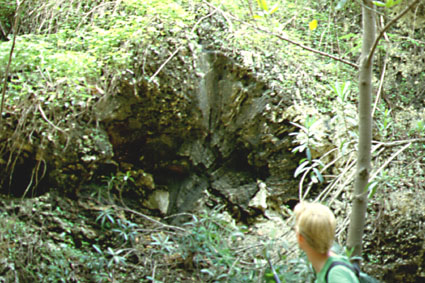 |
The animal hardparts that contribute to limestone formation can be anywhere from
meters (coral reef) to some thousands of a mm (from certain algae) in size. The
picture at left shows a large colonial coral from a Tertiary coral reef
in the Taiwan Strait. Growing over each other, the corals form a solid framework of
carbonate skeletons. Later the open spaces fill with carbonate cement and become
solid bodies of limestone.
|
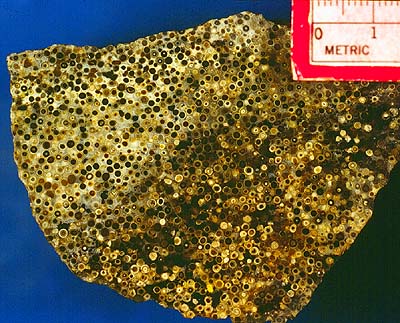 |
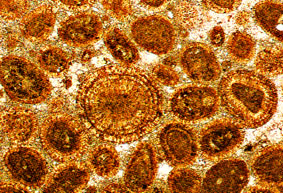 Photomicrograph
of ooid limestone. Grains
are 0.5-1 mm in size. Large grain in center
shows well developed concentric calcite layers. |
Ooids (photo in upper left shows hand specimen of ooid limestone) are the
main form of inorganically precipitated
carbonate and form limestones that look like layers of fish eggs. Ooids form in very
shallow, warm water with
strong wave action (e.g. the Bahamas). A small fragment of carbonate (e.g. a
piece of shell material) is sloshed
around by waves, calcite or aragonite is precipitated on this seed when it rests on the
sediment surface, and then
the precipitate is rounded and smoothed by wave action. Repetition of this process
leads to multiple concentric
layers. There is recent research that indicates that microorganisms may actually be
involved in ooid formation, but
more work needs to be done to firmly establish this. |
DOLOSTONES consist of the carbonate mineral dolomite [CaMg(CO3)2],
and occur in more or less the same settings as
limestones. Even though dolomite can
precipitate theoretically from seawater, it only rarely does, and probably most of the
dolostones in the sedimentary record are due to
post-depositional replacement of calcite
by dolomite (Mg for Ca exchange by Mg-rich pore waters).
EVAPORITES are true chemical sediments. They consist mostly of salt
(table salt [NaCl] and various others) and/or gypsum (CaSO4). They usually
form
from evaporation of seawater. They require high evaporation rates (high
temperatures) for their formation, and usually the sedimentation basin has to be partially
or totally closed off (otherwise supersaturation not reached because of influx of new
water). They usually indicate arid (dry) climate at their site of deposition.
CARBONACEOUS SEDIMENTARY ROCKS are those that contain abundant organic
matter in various forms. Although they make only a small fraction of sedimentary
rocks, they are important energy resources.
Coal, for example is a carbonaceous
rocks that consists of the altered (due to increased pressure and temperature) remains of
trees and other plant material. It has used since the last century for energy
production and chemical industry. Oil
shales are black mudstones that contain
abundant organic matter that has been altered into solid (kerogen) or very viscous
hydrocarbons (bitumen) that can be extracted from the rock through heating.
Tar
sands are sandstones whose pore spaces are filled with heavy crude oil and bitumen.
The hydrocarbons are usually extracted with steam. At current oil prices
(2004-2005) oil shale
and tar sands are attracting interest because some occurrences are are reaching
the point where exploitation becomes economically viable. It is likely that
these more unconventional energy sources become more important as as oil supplies
dwindle over the coming decades.
Sedimentary Structures
are another feature of sedimentary rocks that
allows distinction between different rock units. Sedimentary structures are a
consequence
of the depositional process at a site of deposition. The investigation of these structures
in ancient rocks allows us to reconstruct physical conditions in the past, such as
velocity and direction of depositing currents, emergent or submerged conditions, frequency
of depositing events (storms, tides), and in that way may allow reconstructions of climate
and paleogeographic setting.
Probably the
most important
sedimentary structures are:
There are of course many more sedimentary structures than those. In fact, there
are thick books whose sole object is to describe and discuss sedimentary structures and
their meaning. In a way sedimentary structures are the alphabet in which a lot of earth
history is written, and the better we can decipher them the better will our understanding
of the geologic past (as well as of the future) be.
As we can see from above examples,
the sedimentary structures that we find in today's sediments are the same that occur in
the very oldest sediments known on earth. The
implications of this observation of
sedimentary structures are
twofold:
A) the surface processes of the earth have been the same throughout earth history, and
have been of comparable magnitude.
B) because we can examine what processes produce these structures today, we can go back
and reconstruct the ancient world.
The Origin of Sedimentary Rocks
A sedimentary rock that we can examine in an outcrop has a long history and has been
subjected to modification by various processes.
The first process, WEATHERING, produces the materials that a sedimentary
rock is composed of by mechanical (freezing, thawing) and chemical (dissolution of
minerals, formation of new minerals [clays]) interaction between atmosphere, hydrosphere
and earth surface rocks.
The second process, TRANSPORT, moves these materials to their final
destination. Rivers are the main transporting agent of material to the oceans (glaciers
are at times important). During transport the sediment particles will be sorted according
to size and density (gold placers) and will be rounded by abrasion. Material that has been
dissolved during weathering will be carried away in solution. Winds may also play a role
(Sahara -- east/central Atlantic). The sorting during transport is important because it is
the reason that we have distinct clastic rock types (conglomerates, sandstones, shales).
The third process, DEPOSITION, of a sediment, occurs at a site with a
specific combination of physical, chemical and biological conditions, the
sedimentary
environment.
 |
An overview of sedimentary environments. Environments on land include
(from left to right) Barrier Island, Tidal Flat, Delta, Beach, Fluvial Environment
(Rivers), Glaciers, Lakes Alluvial Fans, Desert Dunes, and Lagoons. Marine environments
include (from right to left) Organic Reef, Shallow Marine (Shelf), and Deep Marine (deep
sea fans, abyssal plains).
Each sedimentary environment is characterized by a distinctive set of features such as,
type of sediment, sediment association, sediment texture, sedimentary structures, and
animal communities, and is in this way (by using modern analogues) that we can go back and
reconstruct ancient landscapes. |
Finally, after the sediment has come to rest,
COMPACTION
and
CEMENTATION
of the sediment occur and a sedimentary rock is formed. Compaction is effected by the
burden of younger sediment that gets piled on top of older sediments (rearrangement of
particles, packing, dewatering). Minerals precipitated from the pore waters in these
sediments cement together adjacent sediment grains. Thus, a coherent solid rock is formed.
Significance of Sedimentary Rocks
 |
That sedimentary rocks are not only nice to look at, but are also
important economic
assets, is something that should be obvious to everyone living in
states such as Texas, Oklahoma, and Louisiana (the oil patch). Until the
early 1980's oil and gas production has been the economic engine for these states, and even
today they produce significant quantities of oil and gas. Indiana also has
oil and gas production, with gas from Devonian black shales (New Albany
Shale in Indiana) being an important economic asset for the entire
northeastern US. |
Not only oil and gas, but also a large variety of other resources are extracted from
sediments and sedimentary rocks. Coal
(mined extensively in southeastern Indiana) and
lignite are special kinds of sedimentary
rocks (carbonaceous sediments; see above), and they constitute a
very large resource that
should last for several hundred additional years. Most of the
iron ore in the world
is mined from Precambrian sedimentary rocks, the largest lead-zinc-silver and copper
deposits occur in sedimentary rocks (mostly Precambrian, especially Proterozoic), and the
largest gold and uranium deposits also are located in sedimentary rocks as well (Archean
to Proterozoic in age). Bauxite, the main ore for Aluminum production
is basically a
fossil soil (also a sediment) that formed in tropical climates. If we then also add
the many building stones that are quarried from sedimentary rocks, and add in the
raw
materials for ceramics (clay minerals from mudstones and
shales), it is quite obvious that
sedimentary rocks are indeed of considerable importance, and that it pays to understand
them well.
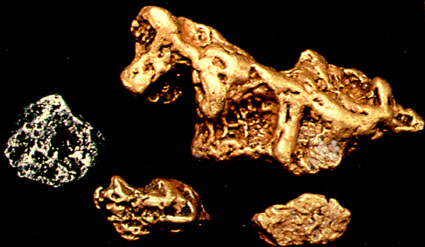 |
Gold and platinum nuggets from placer deposits (river sands and gravels that contain
detrital gold and platinum). Many of the gold rushes in the American West got their
start with the discovery of placer gold deposits. Even today, placer gold mining can
still be a profitable business. The largest gold accumulation in the world, the
Witwatersrand of South Africa, is a Late Archean sedimentary basin with abundant
"fossil" placer gold deposits. |
The hunt for gold always held a special attraction for men.
The Spell of the Yukon
I wanted the gold, and I sought it,
I scrabbled and mucked like a slave.
Was it famine or scurvy -- I fought it;
I hurled my youth into a grave.
I wanted the gold, and I got it --
Came out with a fortune last fall, --
Yet somehow life's not what I thought it,
And somehow the gold isn't all.
No! There's the land. (Have you seen it?)
It's the cussedest land that I know,
From the big, dizzy mountains that screen it
To the deep, deathlike valleys below.
Some say God was tired when He made it;
Some say it's a fine land to shun;
Maybe; but there's some as would trade it
For no land on earth -- and I'm one.
You come to get rich (damned good reason);
You feel like an exile at first;
You hate it like hell for a season,
And then you are worse than the worst.
It grips you like some kinds of sinning;
It twists you from foe to a friend;
It seems it's been since the beginning;
It seems it will be to the end.
I've stood in some mighty-mouthed hollow
That's plumb-full of hush to the brim;
I've watched the big, husky sun wallow
In crimson and gold, and grow dim,
Till the moon set the pearly peaks gleaming,
And the stars tumbled out, neck and crop;
And I've thought that I surely was dreaming,
With the peace o' the world piled on top.
The summer -- no sweeter was ever;
The sunshiny woods all athrill;
The grayling aleap in the river,
The bighorn asleep on the hill.
The strong life that never knows harness;
The wilds where the caribou call;
The freshness, the freedom, the farness --
O God! how I'm stuck on it all.
The winter! the brightness that blinds you,
The white land locked tight as a drum,
The cold fear that follows and finds you,
The silence that bludgeons you dumb.
The snows that are older than history,
The woods where the weird shadows slant;
The stillness, the moonlight, the mystery,
I've bade 'em good-by -- but I can't.
There's a land where the mountains are nameless,
And the rivers all run God knows where;
There are lives that are erring and aimless,
And deaths that just hang by a hair;
There are hardships that nobody reckons;
There are valleys unpeopled and still;
There's a land -- oh, it beckons and beckons,
And I want to go back -- and I will.
They're making my money diminish;
I'm sick of the taste of champagne.
Thank God! when I'm skinned to a finish
I'll pike to the Yukon again.
I'll fight -- and you bet it's no sham-fight;
It's hell! -- but I've been there before;
And it's better than this by a damsite --
So me for the Yukon once more.
There's gold, and it's haunting and haunting;
It's luring me on as of old;
Yet it isn't the gold that I'm wanting
So much as just finding the gold.
It's the great, big, broad land 'way up yonder,
It's the forests where silence has lease;
It's the beauty that thrills me with wonder,
It's the stillness that fills me with peace.
a poem by Robert W. Service
Metamorphic Rocks
Metamorphic rocks are those whose original texture, composition and mineralogy have
been changed by conditions of high pressure and temperature (higher than conditions of
formation of starting material). The materials from which metamorphic rocks form are
igneous rocks, sedimentary rocks, and previously existing metamorphic rocks. Mineralogical
and textural changes during metamorphism occur essentially in the
solid state. Metamorphic
rocks form when the precursor materials (igneous, sediment, etc.) are buried deeply and
are consequently brought into an environment of high pressure and temperature. They are
therefore most commonly encountered in the
core
zones of mountain belts (uplifted root zone), in
old continental shields, and as the
basement rock below the sediment veneer of stable continental platforms.
Metamorphic rocks
and associated igneous intrusions (from rock buried so deep that it melted) make up about
85% of the continental crust.
Metamorphic rocks may contain relic structures, such as stratification, bedding, and
even such features as sedimentary structures or volcanic textures.
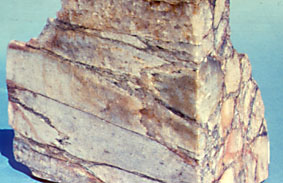 |
Picture of a metamorphosed conglomerate.
The pebbles look "normal" on the right hand cut, but they are much longer
than expected on the left hand cut (perpendicular). The
pebbles were stretched
during metamorphism because the rock was
sufficiently hot to behave plastic and flow. |
 |
Photomicrograph of a metamorphosed quartz sandstone. Whereas the original
quartz grains were probably nicely rounded,
recrystallization under high pressures and temperatures causes the
grains to grow larger
and impinge on each other. The sutured grain contacts that we see are typical for
metamorphosed quartz sandstone. |
The most strongly metamorphosed rocks often show evidence of extensive deformation
without fracturing (in part detectable because of relict structures), and that observation
indicates that these rocks behaved plastically
(see conglomerate above) when they were hot
and deeply buried. Usually, the older a portion of continental crust is, the more
widespread are outcrops of metamorphic rocks (erosion to very deep crustal levels,
isostasy finally exposes root zones of mountain ranges). In older metamorphic rocks
oftentimes several successive episodes of metamorphism can be determined with modern
methods of investigation (age determination on minerals of different stability, different
isotopic systems). Thus, deformation of the earth's crust occurred repeatedly during
geologic history. This is evidence for continued tectonic movements and
readjustments of the earth's crust throughout documented geologic history.
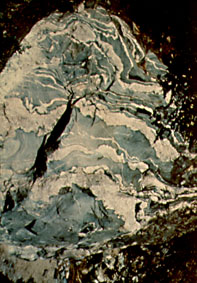 |
Outcrop of a metamorphic rock (a gneiss) that has experienced
high temperatures and pressures. It has developed banding due to mineral
segregation. Folding and deformation indicates that it behaved plastic. The
lighter bands are mostly feldpar, quartz and muscovite, and seem to have undergone local
melting. This rock basically shows evidence of the onset of partial melting in the
lower continental crust, and if the process had gone further it would probably have been
the source of a granite intrusion. These partially melted lower crustal rocks are
also called migmatites. |
METAMORPHIC PROCESSES Metamorphism of rocks (meta=change,
morphos=form; example: caterpillar to butterfly) manifests itself in a series of changes
in texture and composition (mineral composition mainly) that are the result of
readjustment to new environmental conditions (P & T). Readjustment occurs because the
new conditions (e.g. increased pressure and temperatures upon burial in a sedimentary
basin) render the original set of rock components (minerals and pore fluids) unstable. A
new set of minerals (or mineral assemblage) will form that is stable under the new
conditions. In other words, a new equilibrium mineral assemblage will appear (equilibrium
being a state where the mineral assemblage is stable and does not change).
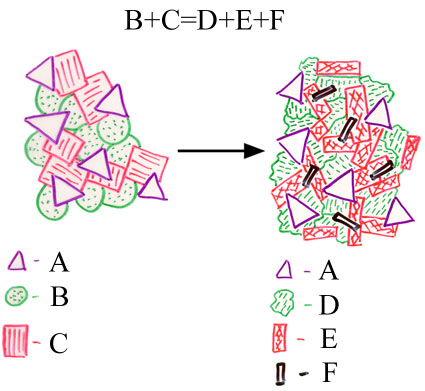 |
Schematic depiction of a
metamorphic change of mineral assemblage.
The initial rock (at left) consists of minerals
A, B, and C that are stable under
the initial conditions. Upon heating and burial minerals
B and C become unstable and
react to form a new set of minerals, D, E, and F, that are stable under the new
conditions. Mineral A is stable over a wide range of conditions and did not change.
The rock looks now
mineralogically and texturally very different from before. |
Metamorphic changes proceed in the solid state (thermal
diffusion). However, water is always present in rocks (pore
spaces in sediments, as thin films between crystal boundaries), and it serves an important
function for local ion exchange (diffusion through the water films). Without water
metamorphic changes would proceed extremely slow because diffusion through solids is much
slower than diffusion through liquids.
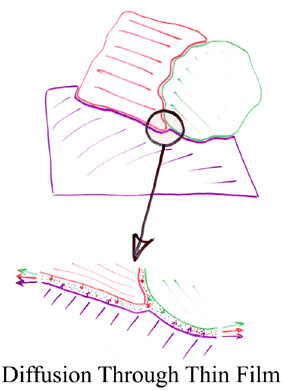 |
Thin film diffusion during metamorphism. A thin fluid film (may be
only a few water molecules thick in places) along mineral boundaries takes up atoms from
adjacent minerals. These can then diffuse through the fluid at greatly enhanced
speeds (when compared to diffusion through a solid). The elements marked in color
are migrating down a concentration gradient towards a place where a new mineral is growing
that uses them up (thus low concentrations surrounding the growing mineral). |
The controlling parameters of metamorphism are:
- Temperature
- Pressure
- Chemical Composition
| The Influence of Temperature: With rising temperature water that is
contained in minerals (crystal water) will be expelled into the pore spaces, fractures and
crystal boundaries. As the pore fluid content increases, chemical changes mediated through
the pore fluids will speed up as well. The
rate of diffusion also increases with
temperature. Thus, new mineral assemblages will appear faster than at lower temperatures.
At temperatures below 200 degrees Celsius, chemical changes proceed so very slow that
essentially no changes occur within geologically significant time spans. At temperatures
of about 700 to 800 degrees Celsius we approach eutectic conditions for most rocks of the
continental crust, and a vapor-rich (water, possibly CO2) partial melt will
form. Metamorphic rocks that have been heated to those temperatures show textural evidence
that significant portions of the rock existed as a melt at one time (migmatite,
see above). Layers of rock with metamorphic texture alternate with layers of rock with
igneous texture, meaning that part of the rock recrystallized from a melt. Those melts are
of granitic composition and may rise in the crust to form granite plutons (we have thus
two types of granites in the crust: those that originated by differentiation of melts
created from partial melting of subducted ocean crust (andesitic magmas), and those that
formed by partial melting of deeply buried continental crust [root zones of mountain
chains, granitic magmas]). The Influence of Pressure: An increase in
pressure tends to favor minerals of higher density, because their atoms are more tightly
packed and the minerals occupy less space. An increase in pressure can be produced by deep
burial of the rock (lithostatic pressure), or by
directed (horizontal) pressure
(stress)
at convergent plate margins (subduction zones).
Minerals will not
grow in the direction of
highest pressure, but rather in the direction of the lowest pressure. Therefore in rocks
that were subject to high pressures, the metamorphic
minerals will be elongated
perpendicular to the direction of highest pressure. Because these pressures do affect very
large volumes (or regions) of rock, metamorphism that causes preferred orientations of
minerals is also called REGIONAL METAMORPHISM. |
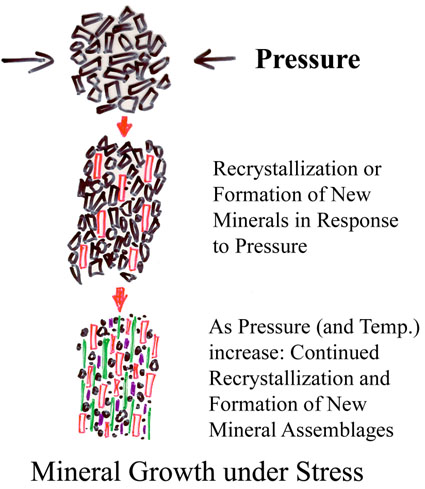 |
An illustration of how directed pressure leads to preferred growth
direction/orientation of metamorphic minerals. Platy minerals such as micas will be
oriented perpendicular to the pressure. Elongate minerals like hornblende will point
with their long axis in the direction of least pressure.
The development of
preferred mineral orientation in metamorphic rocks is called
foliation,
and is typical for regional metamorphism. |
| The Influence of Fluids:
In general, metamorphic changes take
place without significant changes in the overall composition of the rock (we can consider
it a closed chemical system), only local (mm to cm scale) rearrangement of components
occurs. The original minerals break down and a new set of minerals is formed that is
stable under the new conditions (of pressure and temperature).
Fluid between crystals
promotes chemical exchange within the otherwise solid state system. As seen earlier, this
fluid derives from original pore water and water on fractures, and the fluid is enriched
by atoms that are released from crystals. As temperature rises bound x-tal water is
expelled, and some unstable minerals of comparatively low melting point will start to
"melt" or dissolve into these pore fluids. Then diffusion will carry the
dissolved materials to a nearby site of formation of a new metamorphic mineral. This
process of local diffusion and reorganization of the rock into new minerals is called
recrystallization. If on the other hand we have an open, or partially
open system
(plenty of fluid available, high porosity [fractures], e.g. rocks adjacent to a magma
during contact metamorphism), then material can be imported from sources outside of a
particular rock body (which has specific composition),
or can be exported to adjacent rock
bodies. In that case (addition or removal of large quantities of mineral bearing
fluids) the overall rock composition will change. This latter process is called
metasomatism. |
| MINERALS: The minerals that form during metamorphism are
in parts the same as those that we know from igneous rocks (we have to remember that the
early differentiates form deeper in the earth under conditions of high pressure and
temperature themselves). Thus quartz, biotite, muscovite, pyroxene, amphiboles and
feldspars all form during metamorphic processes. However, besides of these minerals
another set of uniquely metamorphic minerals will form. The most common metamorphic
minerals are:
- Chlorite (Fe, Mg - mica type mineral)
- Garnet (Mg, Fe - framework silicate
[high density])
- Staurolite (Fe, Al - silicate)
- Epidote (Ca-silicate)
- Aluminosilicates (Al2SiO5), Kyanite,
Andalusite, Sillimanite
TEXTURES: Aside of new minerals we can also observe
the development of new textures in these rocks.
The most common of these textures is
foliation (layered texture), meaning that the minerals are aligned and grew under directed
pressure (see above). Foliation is caused by formation of new and the recrystallization
(grain growth, coarsening) of preexisting mineral grains (change in pressure and
temperature). Depending on the degree of foliation we distinguish several major
metamorphic rock types. |
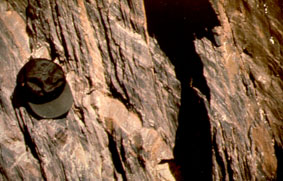 |
Slates are the most fine grained variety of foliated rocks and are
produced by low grade metamorphism of
shales and mudstones.
The most characteristic
feature is the so called slaty cleavage (from newly formed micas). Slaty cleavage
usually is oriented at a high angle to the original bedding of the shales. In the picture
on the left the bedding of the original rock dips at about 40 degrees to the right (sandy
layers in brown), and the slaty cleavage dips at about 80 degrees to the right.
Slates tend to split apart at this cleavage, and fall apart in platy fragments (used in
former times as a writing surface, that could easily be wiped off, A clean Slate).
The development of slaty cleavage depends on the amount of clay and detrital micas
available in a rock (starting material for metamorphic mica growth). |
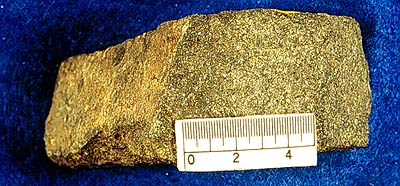 |
Schists
are medium to coarse grained foliated rocks, in which the
parallel aligned micas and the foliation are readily visible to the eye.
They are produced
by medium grade metamorphism, and contain in addition to micas other visible minerals such
as quartz, feldspar, garnet and amphibole (BASIS FOR SUBDIVISION). They do not only form
from shales, but also from other parent rocks such as basalt, granite, sandstones and
tuffs. They are by volume the most abundant metamorphic rock type. The picture at the left
shows a handspecimen of greenschist. The greenish mineral in the foliation plane is
chlorite. |
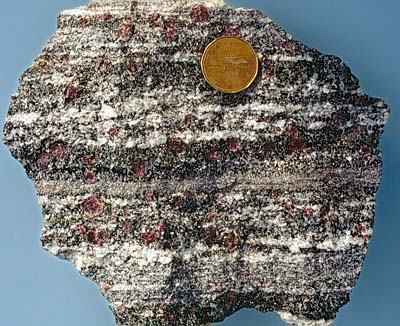 |
Gneisses are very coarse grained metamorphic rocks that form during high
grade metamorphism. They are distinctly banded
(segregation of newly formed minerals into
bands), and their main minerals are quartz, potassium feldspar, and biotite or hornblende
(ferromagnesian minerals). It is of similar composition than granite, and if a gneiss is
heated just a little bit further, a granitic melt will rise from it. The picture at the
left shows a garnet-biotite gneiss (garnet are the reddish spots, the black mineral is the
biotite) with quartz-feldspar groundmass (white-gray). |
| Metamorphic rocks can of course only be foliated if the composition of their parent
rocks allows mica formation. Thus,
the metamorphic products of certain parent rocks will
be nonfoliated. Such rocks would for example be quartz sandstones (transforms into
quartzite, interlocking quartz crystals, see above), limestones (transforms into marble,
coarse crystalline, interlocking calcite crystals, impurities in the original limestone
will show as colored streaks or as mottling), and basalt (transforms into amphibolite,
predominantly hornblende and plagioclase).
Hornfels (a rock [from German
"Fels"] that is as hard as a horn), is another
nonfoliated, fine grained
metamorphic rock. Usually it is
dark colored, fine grained and hard. It occurs typically
in metamorphic aureolas around intrusions (contact metamorphism).
Especially in the case of higher grade metamorphism, crystals can grow in the rock that
are considerably larger than the average grain size in the rock (garnets, staurolite).
These large crystals are called porphyroblasts (from Greek
"blastos", to grow) in analogy to porphyric crystals in igneous rocks.
The NAMING OF METAMORPHIC ROCKS: Is
done by combining the most abundant minerals and the textural type into a name. E.g.
Garnet Hornfels, Quartz-mica Schist. In some cases the prevalent color of the rock may be
used instead of a mineral name, particularly if such color is due to a certain mineral.
E.G. metamorphic rocks with chlorite tend to be of greenish color, and therefore the name
greenschist instead of chlorite schist may be used (its the older name). |
ORIGIN OF METAMORPHIC ROCKS
Principally, metamorphic rocks form in two types of settings:
- At convergent plate boundaries where crustal rocks are buried deeply
and experience high pressures and temperatures. Because of the moving plates, there
is a direction of highest pressure and foliation typically develops. This type of
metamorphism affects very large areas and is known as
regional metamorphism.
- In the vicinity of igneous intrusions
where the surrounding rocks are
heated by the ascending hot magma. This kind of metamorphism is called
contact
metamorphism.
Regional Metamorphism |
 |
Within Regional Metamorphism, there are
three principal
regions that differ with respect to prevailing temperatures and pressures.
The rocks are all characterized by foliation, but they differ in their
mineral assemblages.
Low temperature/high pressure metamorphism
characterizes the areas where cold oceanic crust is pressed against continental crust.
Portions of oceanic crust may be sliced off and accreted, and the characteristic
mineral is a blue hornblende (glaucophane) that gave rise to the name
blueschist.
The root zone of the
foldbelt is heated by intruding andesites and deep burial, and it is
there where we also have the highest pressures. In this
high
temperature/high pressure region we will see metamorphic rocks that
typically contain pyroxenes and garnets. Higher up in the foldbelt we encounter the
low temperature/low pressure region, characterized by chlorite, the so
called greenschists. |
Contact Metamorphism
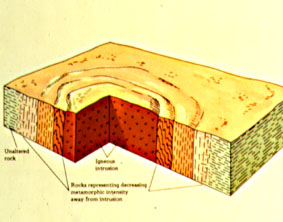 |
In regional metamorphism, because of the large distance to cover, it is not easy to
see different mineral assemblages (in equilibrium at different temperatures) right next to
each other. In contact zones around igneous intrusions (CONTACT METAMORPHISM)
these relationships are more readily observable.
As the magma cools it heats up the
surrounding host rock. The host rock is hottest right near the contact and then the
temperature gradually declines away from the intrusion. Parallel to the temperature
decline we see a progressive change of the mineral assemblage. We can see how a rock
of a certain chemical composition, when heated up gradually, shows a changing mineral
composition that reflects the temperature gradient around the cooling intrusion. In
the picture at the left, the red center is the intrusion, and the zones of changing color
and texture around it are contact metamorphic zones with changing mineral assemblages. |
Chapter 6 (don't use this link)
Go back to
the links page and click on Part 2 (chapters 6-10)



























